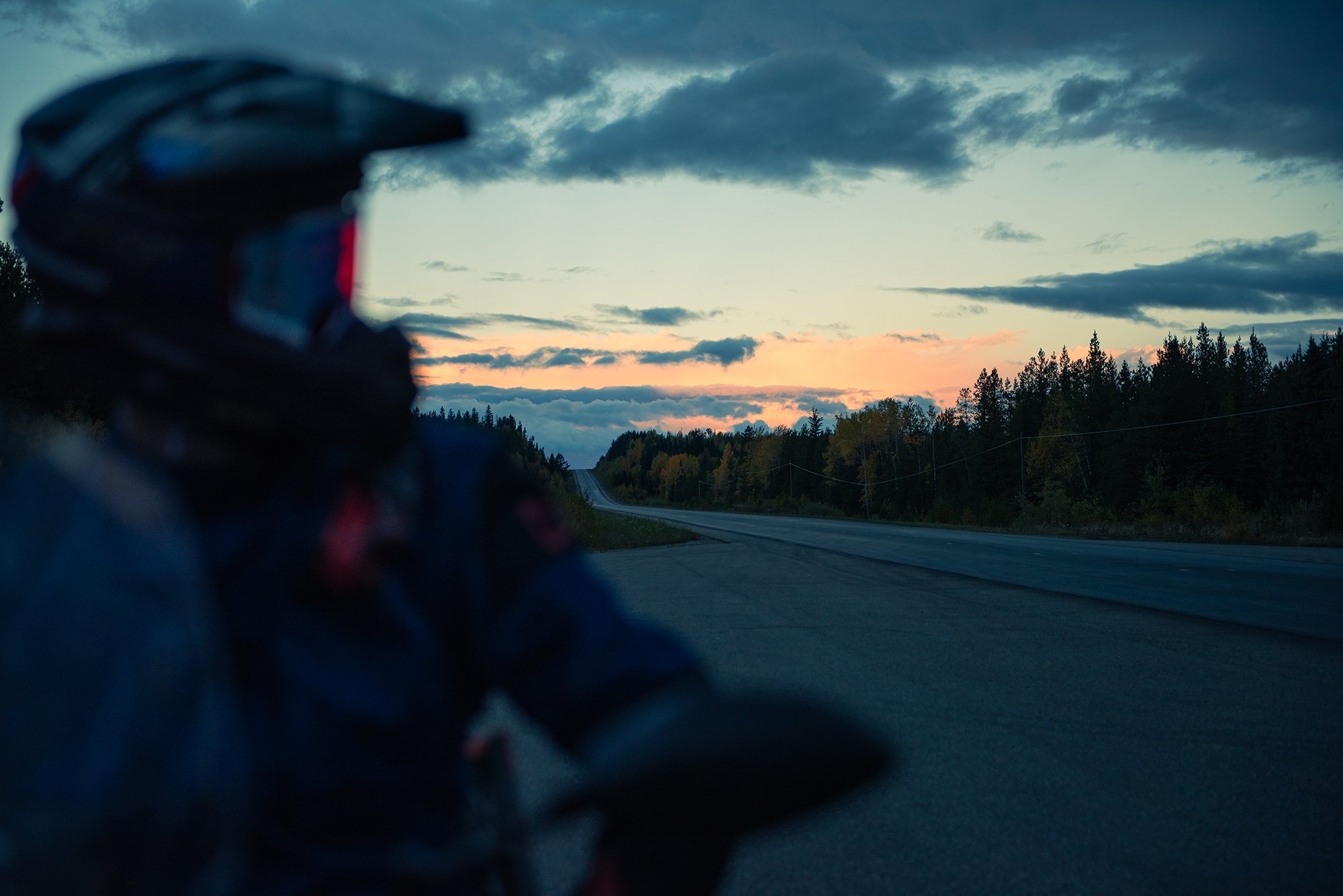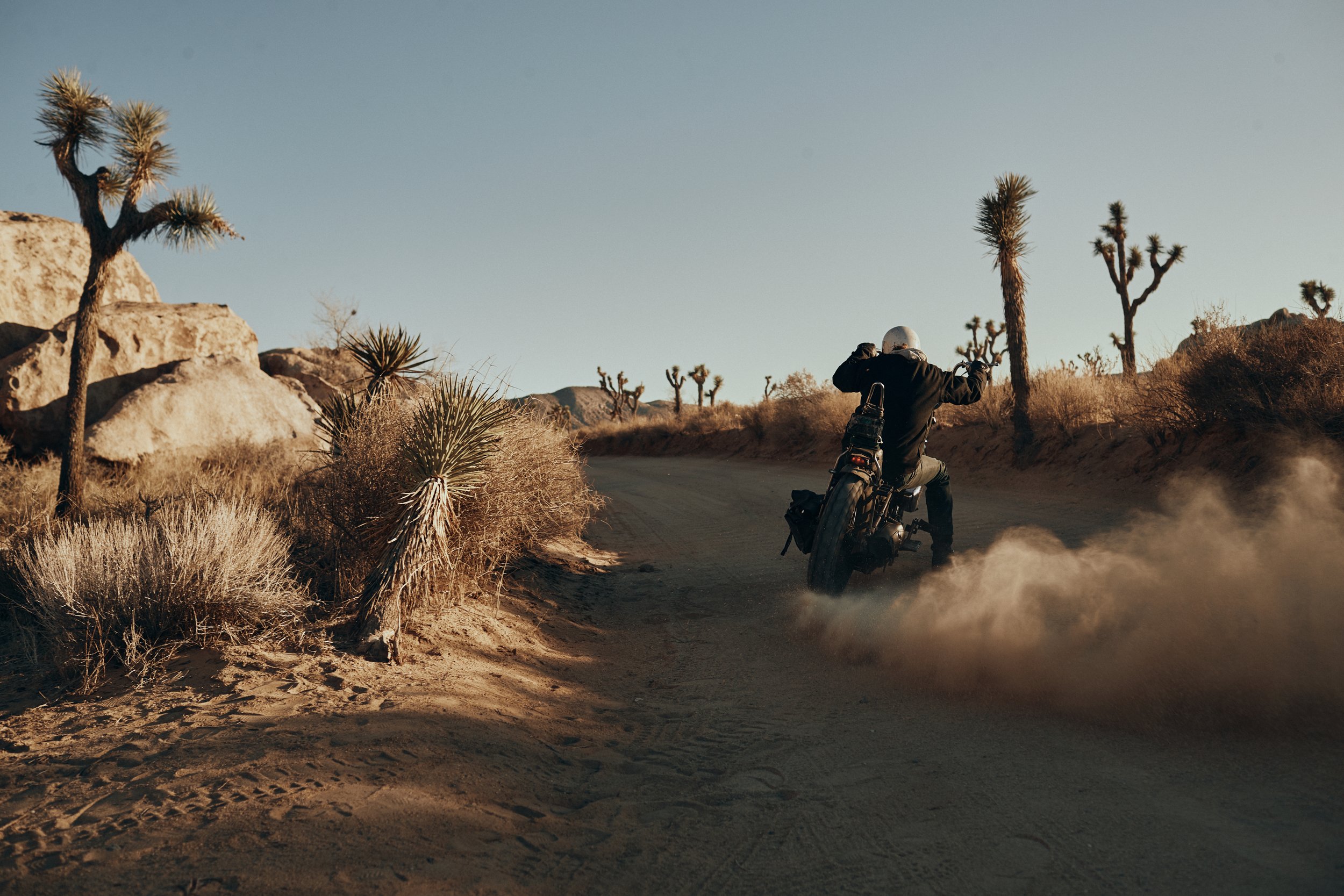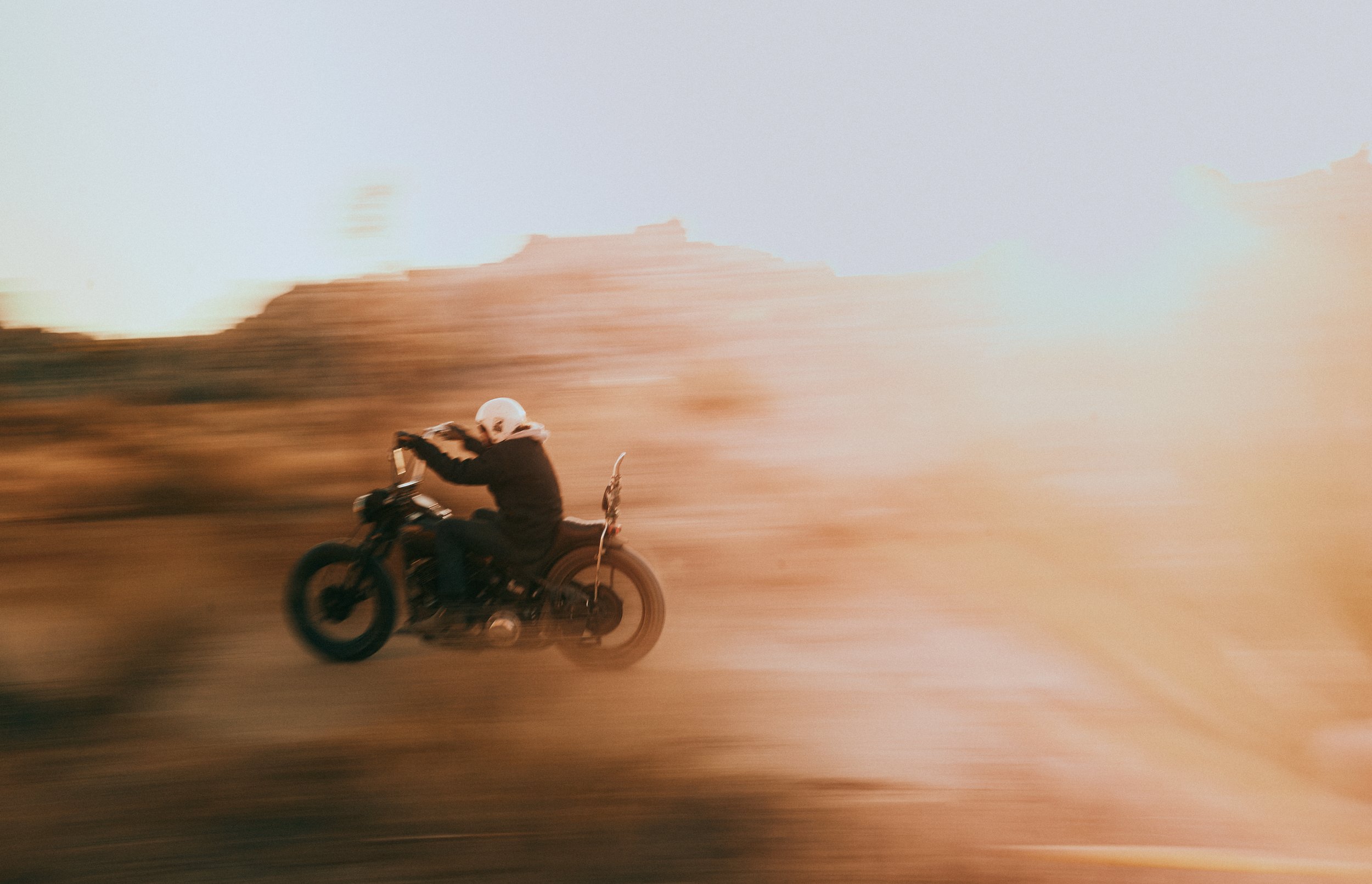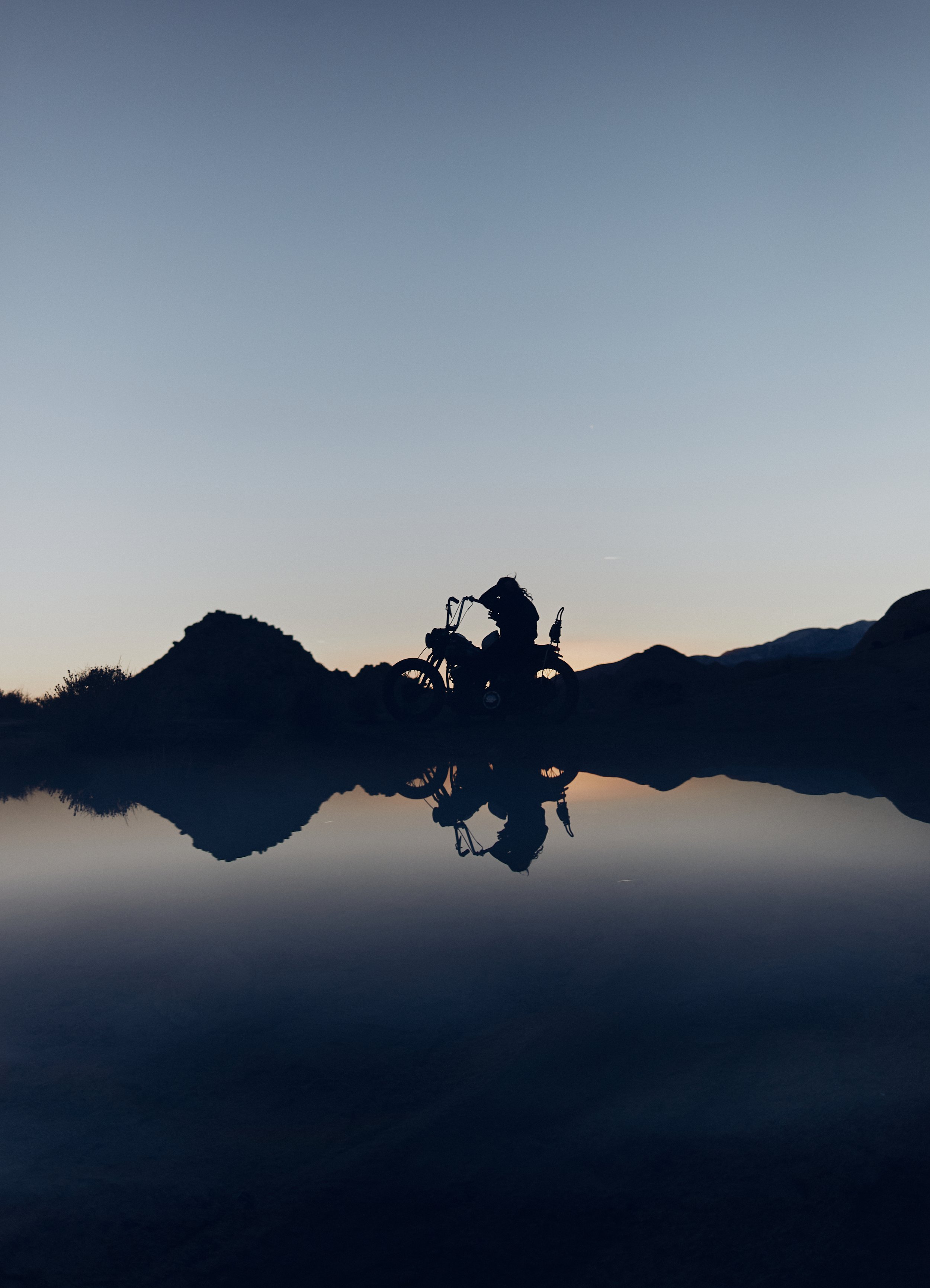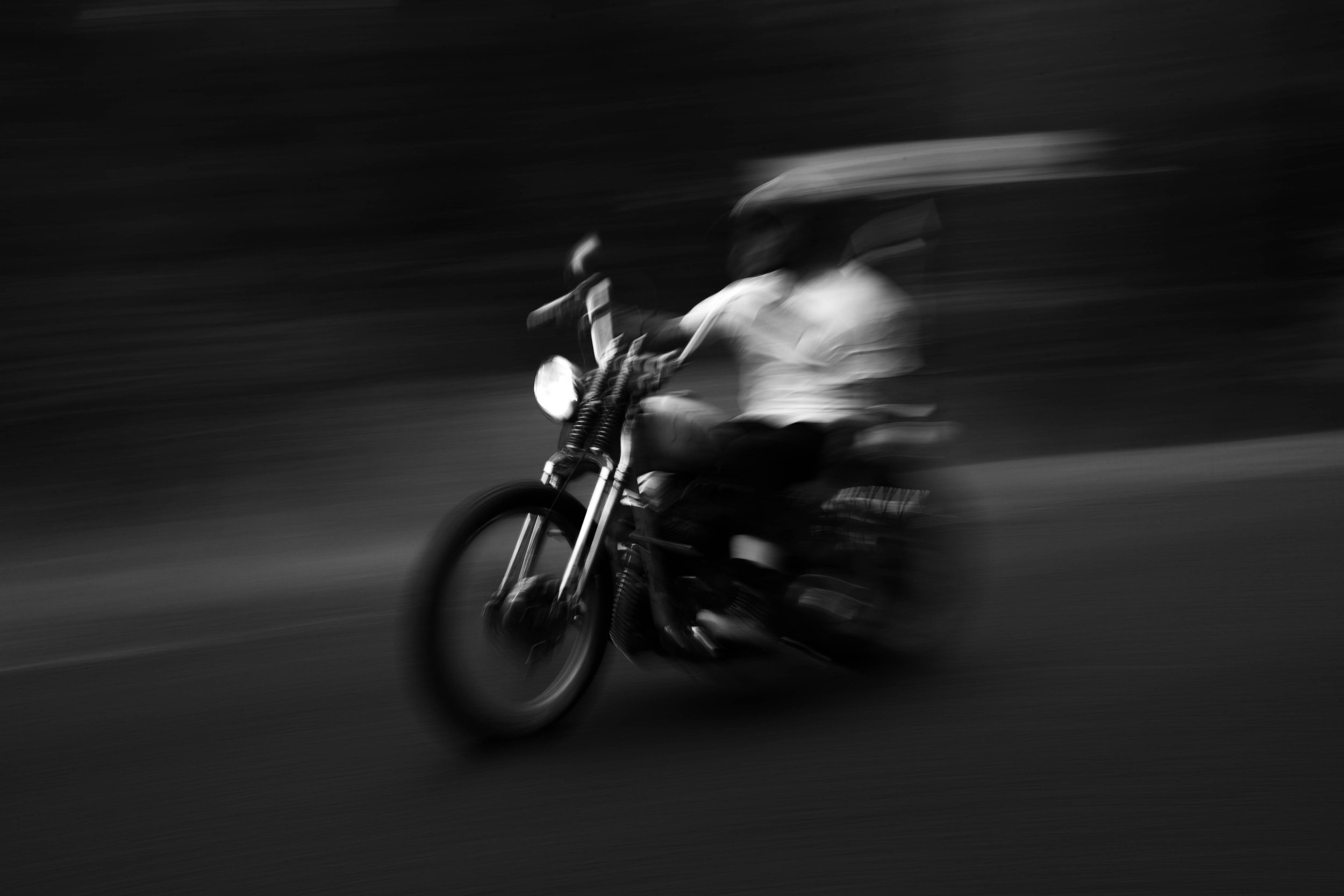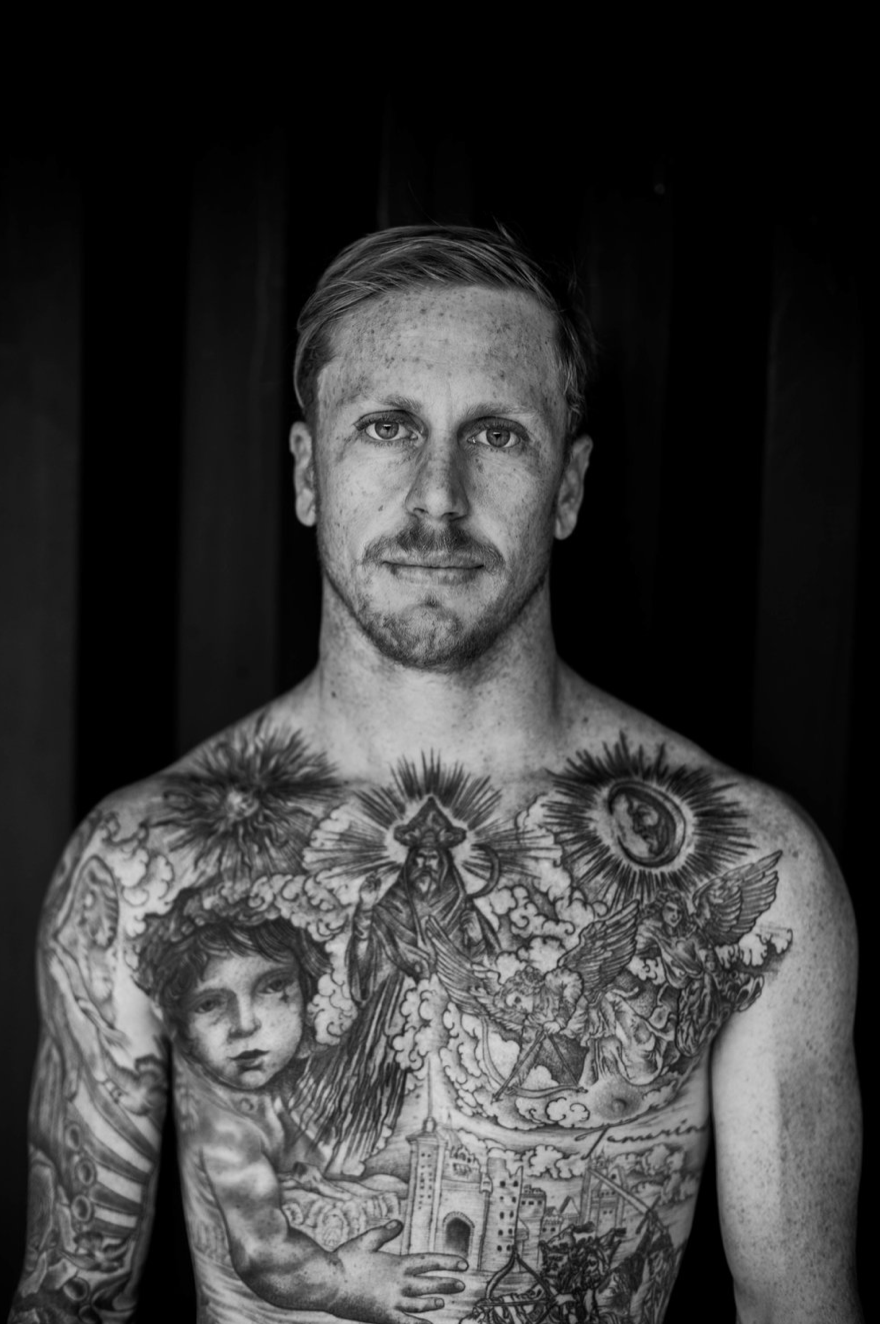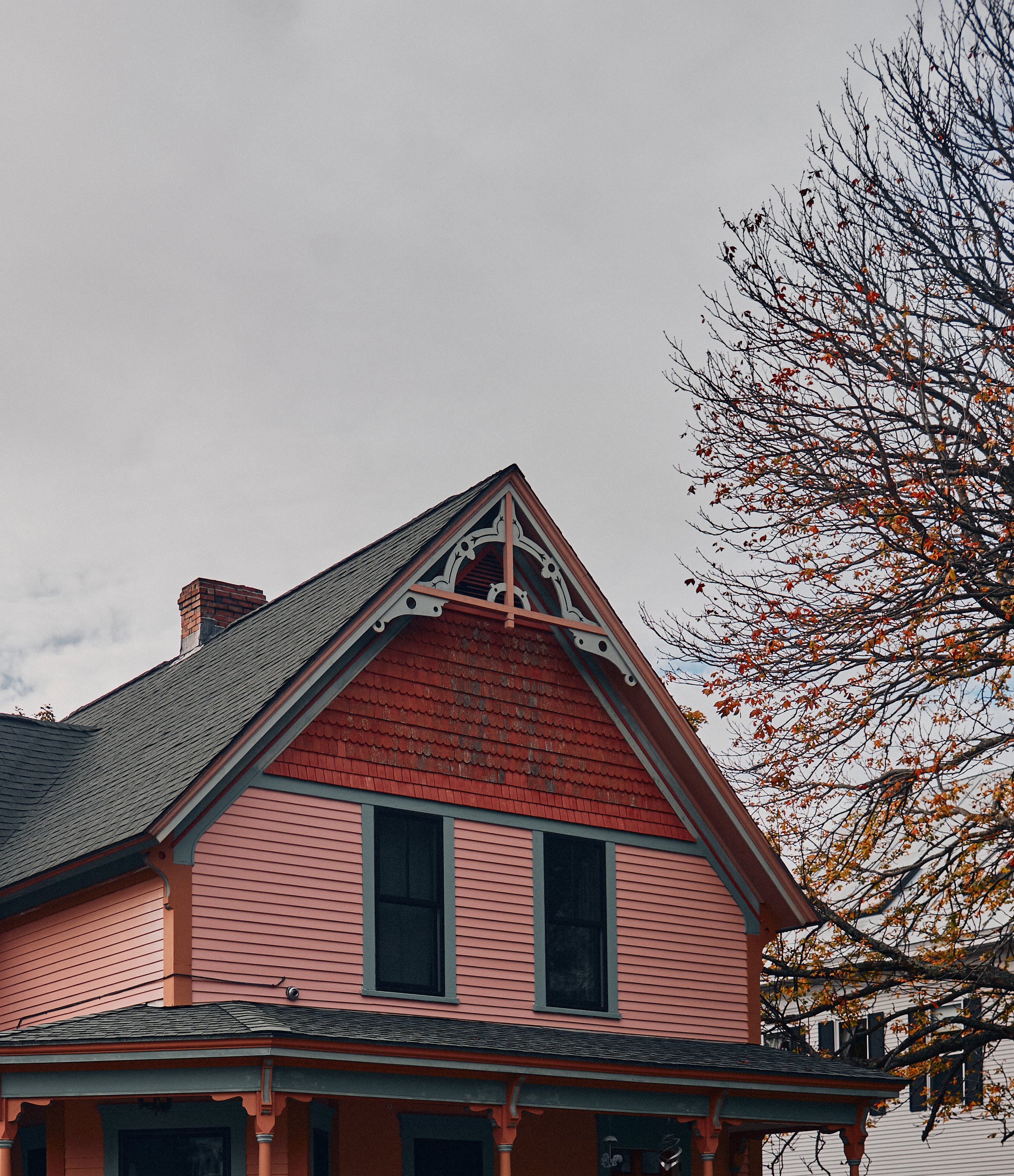WHERE THE DUNES MEET THE SEA ON THE COAST OF ANGOLA
Words by Adam Lyman | Photography by Archie Leeming
Ican’t do this, man.” I sat on the hard mattress of the dingy border-town hotel room and said the dreaded words. Silence. Archie Leeming, looking tired, calmly paused his packing. We were both exhausted. I was at my wit’s end. I had to break the news; I couldn’t take the intensity of this trip anymore. It had been a wild journey already, fraught with frustration and challenges. And yet the “real” trip had yet to begin. The Death Acre in Angola — the southern African nation officially known as the Republic of Angola and an adventurer’s dream — was still ahead of us. But we had been met with relentless struggle already, and I didn’t think I could be a good travel partner if we continued.
A strained conversation ensued. We were both a bit upset. The trip wasn’t supposed to end this way. We had been planning it for nearly nine months and had been so eager. At this point it felt like it was supposed to happen. But I couldn’t seem to change my feelings. By choosing not to go, I threw Archie’s entire trip off. The Death Acre is not a place you go on your own, so without a travel partner, his dreams of exploring the coastal dunes of Angola were dashed. We packed the rest of our gear in silence and trudged out of our damp, shabby room with dusty panniers slung across our shoulders. A three-wheeled motorcycle with a covered cargo bed putt-putted into the courtyard to take us and our gear back to Angolan customs, where our bikes had been stuck overnight.
The Death Acre is a 50-mile section of coastline in Southern Angola. Here, mountainous dunes rise immediately from the sea’s edge, ending in towering peaks of sand. There is no beach, no border between the wall of sand and the ocean. Normally, there is no way to cross this section by land. However, at certain times of the month and according to moon patterns, the tide recedes to reveal a temporary passageway wide enough to pass between the sea and the dunes’ edges. But after a window of a few hours, the ocean returns to the foot of the dunes, swallowing your tracks and any vehicle that remains. This is what we had come to explore. But the thought of doing so was very foreboding.
To even be at the Angolan border was a feat of its own. Two weeks prior, Archie and I had met in Windhoek, Namibia, after journeying several thousand miles each to get there. I was coming down from Northern Zambia, and he up from Cape Town, South Africa. And what a journey it had been. For months we had poured our hearts and souls into our old, classic Honda motorcycles for this trip. I had completely rebuilt my 750cc Africa Twin from the frame up, and Archie had freshly rebuilt his engine and carefully customized his XR600R for the long-range adventure. We lived and breathed old bikes, and our trip to the Angolan border had been a trial by fire, as it was the first time both bikes had been ridden fully reassembled.
Naturally, Murphy and his law had it out for us the entire time; anything that could go wrong seemingly had. Mechanical failures. Electrical failures. Engine problems. We quickly occupied any garage space across Southern Africa that we were allowed into. Some people would call it “chaos,” but to us it was just standard procedure. It seemed like there had already been at least two separate trips within this trip. I was beyond exhausted. We had chosen our hill, and the odds weren’t looking good. I was ready to surrender before that proverbial death.
I gazed out the back of the three-wheeler, watching the chaotic road scene unfold as we plodded toward the border. People in flip flops drove small motorbikes in every direction on a packed road, zigzagging every which way. Crowded storefronts lined the street. A cow stood alone in the middle of a grassy roundabout. I was still going back and forth in my mind about my decision. We had been committed to this trip together for a very long time, and as we get older these opportunities are getting harder and harder to come by. There was a lot of momentum riding on this trip, but at this point I felt like we were pushing a rock uphill, knowing full well we may get crushed by it if we kept it up. Then the putt-putting of the three-wheeler slowed, and I snapped out of it as we stopped in front of customs, where our bikes had been held overnight.
Technically, the border was closed due to COVID-19. We weren’t even supposed to be here. Everyone in Namibia had told us crossing was impossible. Until we convinced him, the Namibian immigration officer was not going to stamp us out of the country. The day before we had failed to cross into Angola because the immigration officer in charge of processing our visas was at church. So, stranded and destitute without passports, motorcycles or money, we were forced into a dodgy, humid and mosquito-infested hotel room near the border. Stranded and destitute was the last sign I needed to tip my decision-making scales.
As we trudged back up to Angola immigration, the officer in question came bursting out of the door holding our visas over his head, beaming with excitement. He spoke good English and had been very helpful so far, completely unphased by the border closure. “Are you guys ready for Angola?” he asked cheerfully. I countered with my somber news: We would be turning around and heading home. He looked very confused, almost concerned. “But Angola needs you!” he pleaded. I saw Archie cracking a smile in my periphery. The officer was in his corner — the last-ditch convincing effort he needed. “I’ve already processed your visa; everything is ready to go!” We were silent. Archie was gleefully holding back from piling on with convincing remarks. So, the officer continued for him, “There is nothing to worry about, where you are going it’s so beautiful. Just come, don’t worry.”
I smirked and shook my head. This situation was so absurd. I looked at Archie, and he was laughing. The tension between us was broken. I looked at the bikes. Then toward the locked gate at the end of immigration and customs. We had come all this way.
We excused ourselves for a minute. I walked around the building and sat on the curb next to the bikes. Several possible scenarios flashed in my head — some realistic, some fear-based. What if the trip takes longer than we expect? What if the bikes break down (again) and it becomes a massive undertaking to extract? What if the COVID situation changes and Namibia or Angola locks down their borders? I looked at the bikes. Back at Archie. Back at the gate into Angola. I could hear the voices of all the reasonable people in my life saying how terrible of an idea it would be to go through that gate. “Real Africa” was behind it — anything was possible once we stepped through. My head was in a fog from our night of battling mosquitoes and heat. On top of being road weary. We hadn’t had a proper meal in days. I was blank. Several moments passed.
“All right, let’s fucking do this.” I stood up confidently. Archie beamed, and we hugged. It was on. Tension turned into teamwork. Back around the corner the immigration officer stood excitedly waiting with our passports in his hands. He might have been as excited as we were when he heard the news. All of us cheered. A few stamps and papers for the bikes later we passed through the gate and were on the road into Angola.
Everything changed as we crossed the border – the language, the people, the culture. We switched from driving on the right to the left. People, animals and other random objects poured into the streets. There were abandoned, rusted tanks sitting along the side the road, their turrets pointed south toward Namibia, remnants of the devastating civil war that had occurred mere decades ago. Empty hotel and housing projects sat idle. It felt strangely eerie, like driving through a documentary of the Soviet Union in the ’80s, but this was Africa. European architecture and pastel-colored buildings dotted the roadside, making things even more confusing. But everywhere we stopped, the warm, relaxed nature of the people we met immediately shattered the artificial cold projected by these historical remnants.
Our route took us northwest from the border along the single tarmac road headed toward the town of Cahama. There was hardly anything there, just a handful of small shops along the road for a few hundred miles. A horde of small bikes crowded around a large above-ground fuel tank. We pulled in. Eminem was blasting on a cheap Chinese stereo. We filled up all fillable containers we had with fuel and water — from here on out there wouldn’t be any official fuel stations. There may be fuel in the villages, but there was no way to tell. I scrounged up some grocery supplies. We would not see another tarmac road until the end of the trip, several days and nearly 1,000 miles later. Well, we weren’t exactly sure what we would see.
There is something so enticing about heading into the unknown in a totally different country, with a completely unique landscape and culture. We pointed our fully loaded bikes into the sunset over the scrubby, bushy scene before us. From here, we’d head west toward the ocean across several hundred miles of remote bush track before reaching the start of the Death Acre. For us, the Death Acre was the proverbial summit of the trip. The last, most difficult task lying ominously at the end of the challenging track to get there. That morning’s drama slipped far into the background as we started off into the dying sun looking for a place to sleep in the bush.
Dusty roads. Cool mornings, and hot days. Spirits were high — the riding was incredible. I danced on my foot pegs to the Grateful Dead blasting in my helmet as we weaved in and out of the rocky track flowing up and down through the bushy desert that slowly turned mountainous. This. This is why we do this. Exploring the far corners of the world with a good friend, loaded up on bikes we had transferred part of our souls into. We were firmly in the ever-elusive “zone.” Things were coming together. All memories of past suffering faded away. What was up next? When was the last time a foreigner had been down these roads? Months? Years? Each small town we came across felt like an oasis. There weren’t many, but every few hours a village would appear out of the dry, barren landscape. Over the next few days, the villages became smaller and smaller, farther and farther apart down more aggressive roads. Only a few hundred more miles to the ocean.
Iona National Park was the beginning of the endless sand. Deep sand. We trudged through the ruts of 4x4 tracks that had gone before us heading for a ranger station. This would be our last checkpoint before the open desert and the start of the Death Acre. We didn’t know what we would find at the station, so both Archie and I were completely loaded with water and fuel. A 23-liter tank of fuel, plus six more liters in an auxiliary bag. Eleven liters of water. I could feel the weight of the Twin, now very top-heavy, shifting from side to side violently in the sand. We were both tired, but all remaining energy reserves were focused on keeping things upright and moving fast enough to maintain balance, and not get sucked into the bottomless fluff. Every now and then I’d break concentration to remind myself to take in the increasingly rugged, unearthly scenery unfolding around us.
Around midday we pulled into the ranger station in Iona. It was a simple camp, consisting of a few rows of block housing where we were offered to stay the night. We looked at each other. A real bed? Indoors? Behind the station was a sea of infinite desert. The mountains were no more — it was nothing but sand between us and the ocean. As we parked under the shade, I could see heat waves rolling off the surface into the horizon. Around sunset we hiked up a nearby mountain. From the top we had a 360-degree view of our surroundings. The geological shift was clear. There was no one else here. It was quiet. Barren. Isolated. Majestic. Ominous.
From the ranger station, we still had to cross the 60-mile section of desert plain that lay before us. There was no official road here – just open desert with faint two tracks in the windswept sand. Eventually they would lead to the Foz do Cunene, or “Mouth of the Cunene,” which was the border between Angola and Namibia. There was a small police post guarding the border, nestled in an abandoned colonial settlement from the 1800s, amongst the dunes. Next, we’d ride along the brooding, desolate coastline for about 60 miles north from the police camp, where the Death Acre would begin. The whole area was wildly remote. Nothing but sand, wind and water for hundreds of miles. Cell signal had stopped four days ago.
We went flat-out Dakar Rally-style, pinning the bikes racing side by side like ink pens drawing a route on the surface of the blank virgin sand. Archie had the coordinates on his GPS, and we followed that line along with some faint tire tracks in the sand. We couldn’t afford to get lost out here. The conditions were too harsh; the stakes too high.
As we got closer to the ocean, the flat desert turned to dunes, gradually becoming larger and larger. The sand shifted back from hard pack to soft beach. This is where Archie’s XR600R was at its best. I, on the other hand, with a fully loaded Twin, was pumping the throttle to keep the ship afloat. If we stopped at the wrong spot — at the bottom of an incline, or the middle of a loose sand rut — we could get very stuck. So, we had to keep the speed up so that the bike could remain afloat above the sand — but not too fast, because the dunes were laden with treachery, oftentimes concealed. Most common was a hidden ridge: A dune face that appeared to gradually slope down the other side could drop off unexpectedly, leaving a sheer drop. Depth perception among the dunes was difficult to ascertain, so it was hard to tell which ridges dropped off and which ones didn’t.
Archie stopped and looked down at his front tire. It was flat. We were already pressed for time, and this was an unfortunate setback. There was no shelter out here, and we really needed to make it to the river mouth if we had any chance of crossing the Death Acre the next morning. A puncture two hours before sundown, in the middle of the desert, with little backup options available, was the worst-case scenario. Here we go — this is what we had trained for on all our previous trips. We went through the motions of changing Archie’s tube as the late-afternoon sun beat down and the wind whipped sand across our face. I could smell the sea in the intense wind blowing from the coast, which still must have been many dozens of miles away.
The sun set over the dunes, and the sea mist rolling in from the ocean was fogging up my goggles. We still couldn’t see the ocean, but the smell and heavy air was unmistakable. As we got closer to the ocean, more and more rocks appeared, hidden in the dunes. There was more wind here, too. We were so close, but that didn’t really matter. Each mile had potential for danger and getting very lost. Things were getting dicey now as darkness set in. We were pushing. Up and over the dunes, one after the other, going faster and faster with a sense of urgency. Eventually we crested a rolling dune and saw the ocean in the distance. I was in disbelief that we were actually here after all we’d been through. But there was no time to celebrate, as we had to find our camp.
An eerie, abandoned settlement rose out of the desert to greet us in the dusk. Tucked into the dunes and set back from the sea was a smattering of concrete block houses. Their paint had faded years ago and stood as gloomy gray dwellings in an already bleak landscape. Most of the houses were rundown and ramshackle, with roofs falling in, or filled with sand that had blown into their open doors and windows.
Guards appeared out of the block houses near the entrance to the village. People. There were people here. How was that possible? Their cheer and friendliness immediately cut through the town’s eerie darkness that at this point was both quite literal and figurative. We were welcomed by the guards, who took our details, effectively checking us “in” to the abandoned village.
In the last remaining light, we rode our bikes across town over to the ramshackle pump house at the edge of the river where we would sleep. Busted-out windows and graffiti added to the ghostlike feeling. Large pipes twisted in various arrangements were still scattered throughout the house, which looked directly over the river, which was something of an anomaly itself. A wide ribbon of fresh water winding its way through the dry, sandy desert, eventually dumping into the ocean. We later found out the river was packed full of crocs and a variety of sharks, adding to its exotic appeal.
There wasn’t much time to take in how incredibly peculiar the whole settlement and situation was because we had to begin preparing for tomorrow. Our attention turned to the task at hand. I could feel the weight of the following day when we would make a go at the Death Acre.
Archie’s alarm pierced the early-morning stillness. It was 4:30. Coffee, oats, a few quiet moments by the river. I looked for crocodiles. Nothing. The sun crested the top of the dune opposite the river. Time to go.
If all went well today, we would be camping in the middle of the Death Acre section. Archie had GPS coordinates to meet up with a group for a tour from a place called Flamingo Lodge going to Baja dos Tigres tomorrow and camping in the dunes for two nights. Our plan was to meet up with our guide at their camp and join the tour. If we made it on time. Through a variety of satellite communications Archie had arranged an hour window to meet them between 11:30 and 12:30.
Both Archie and I had been on a lot of trips to obscure places, but there was something different about today. I could feel it. This was serious. Countless things could go wrong very quickly and easily. Seamless execution was dependent on our skill, focus and preparation. Past images of sunken Land Rovers and motorcycles being hauled up a dune away from the incoming tide crossed my mind. Stories of experienced motorcyclists going headfirst over a dune and breaking bones surfaced. If anything went wrong, help wouldn’t be easy or guaranteed. Definitely not fast. Things were serious.
We started off. There was roughly 60 miles of challenging coastline to cover before the official start of the Death Acre. But there was no road. It was up to us to choose the right line, which was nearly impossible. Each line has its own perils. Near the ocean, riding was flat, but occasionally saturated sand would become quicksand, instantly stopping us in our tracks. Or a rock outcropping sticking into the ocean would block our path, and we had to go up and over the sandy bank to gamble on the inland line. Once inland, we were faced with deep beach sand and dunes with huge whoops, boulders and drop-offs. Rock chunks that could easily take out an engine case were hidden by the sand. The sand was anything but flat. Ramping off a dune, or diving into a hidden crevasse, seemed inevitable. One mistake and we’d go over the handlebars, breaking the bikes or ourselves. My adrenaline and focus had never been higher. Sure enough, both of us eventually dumped our bikes down a false dune side, luckily avoiding any critical damage or injury.
After many hard-fought miles, we reached the start of the Death Acre — marked by the towering dunes appearing out of the desert plain. Fortunately, the conditions made the famed Death Acre riding much easier than what we had just completed. The sand in front of us, recently covered by water a few hours prior, was hardpacked and gave us no issues. It was a calm, sunny day. We made good time. The scenery was beyond epic, unlike anything I had ever seen in my life. We were happy and smiling, and we had plenty of time to mess around and shoot some photos.
And then I got lost. Archie and I were separated for nearly an hour. I made a wrong turn into a false lagoon created by ocean currents. What appeared to be coastline eventually disappeared into the ocean. I didn’t have the GPS, or any way of knowing where I was, or where Archie was. I didn’t realize I was lost and waited for Archie to catch up, not knowing he had already passed me farther inland. Maybe he was having mechanical issues again, I thought. I waited. Nothing. Meanwhile, unbeknownst to me, Archie was completely panicked. He drove up and down the coast searching everywhere for me, writing notes in the sand, worried I had been lost and then backtracked. By the time we finally met again, he was rattled, and another hour was gone. We were pushing time again, putting our meetup window in jeopardy.
We continued riding up the coast. Dune ridges, towering over the ocean, wound northward as far as we could see. Past the lagoon, riding was easy again, as we flowed in and out of the curvature of the dunes. We made good time again, although still wary of our past hindrances.
Eventually Archie stopped abruptly on the coast. “This is it, the GPS coordinates. Camp Relief should be a few hundred meters that way.” He pointed at the massive dune to our right. Finally! We were in a celebratory mood — the highest of highs. Archie was beaming. The apex of our trip! We had done it! There was still sand in both of our helmets from when we had dumped our bikes over dunes earlier this morning. I had several near-misses with boulders. But we had made it. Months of planning and prep and hardship resulted in this moment. The trials and tribulations to get here were substantial. Just a week ago I had reached my wit’s end, and nearly turned around. But here we were.
Time for a tea and snack by the ocean. I dug out the last bits of biltong (cured meat strips) and dried mangos — luxuries I had saved from Namibia. This was a real celebration. I suggested we move the bikes down to the water to create a makeshift shelter to protect us from the hot midday sun and slight offshore breeze. Still chuffed, we walked to our bikes to move them.
Thwap, thwap, thwap. Archie looked at me with a horrified face. His kicking intensified. Thwap, thwap, thwap. Nothing, not even a single fire. He kept kicking in denial. Several minutes passed. This might be one of the worst places for the bike to give up. Both our minds were racing. What if it actually didn’t start? What if we were stuck in the middle of the Death Acre with a bike that’s not working and no backup on the way? Thwap, thwap, thwap.
I suggested we go have that cup of tea, cool off, enjoy the surroundings a bit and not think about it right now. But it was too late. Archie had already begun spiraling — as one would — when you may be stranded in the middle of possibly the most remote desert location in the world. After 2 p.m. that day, the tide would come in and then no one could reach us by land. Our high had crashed immediately. The mood was again one of frustration and hopelessness.
We had our tea. Archie was visibly upset and disgruntled. I tried to provide some comfort and be a steady voice of reason, but even I could tell that the situation looked a bit bleak. Eleven-thirty turned into 12:30, which turned into 1:30. What if we waited too long, then missed our window to get out of the Death Acre? Do we camp here for the night? Will Archie’s bike start again? What do we do if it doesn’t?
I took another sip of tea and stared out over the ocean. In front of us to the north, the coastline swooped around, jutting out to a point. I fixed my eyes on that point. If our guide comes, it will be around that point. No sign of a vehicle yet. Meanwhile, our surroundings didn’t seem to care about our internal turmoil. Everything was still. A calm, turquoise colored sea gently lapped the shore. Periodically the wind picked up across the sea, blowing bits of sand up and over the lonely dune peaks. Seagulls rode the thermals, hovering just over top the mountain of sand. Their shadows danced across the face of the dune below. A jackal sat completely still halfway up another dune, looking at us curiously. I broke the silence with another attempt at keeping the optimism up. We had the essentials. We had prepared for this. There was enough food and water for an emergency overnight. It might not be ideal, but it was fine. My words seemed empty, hardly comforting in the void that was our current environment. There was nothing left to say, so we sat in silence, both running scenarios about what might unfold.
“What’s that?!” We strained our eyes toward the point like stranded sailors desperate for rescue. Nope, that was just a dark rock I hadn’t seen yet. We eventually gave up and walked back to the bike to inspect it. Seat off, tank off, luggage spread everywhere. Standard procedure. We checked the spark plug, and sure enough the spark was weak. It was yellow. Sometimes. Other times there was no spark at all. Without a multimeter we couldn’t pinpoint the problem exactly. All we could do was hope there was enough spark for enough of the time to get us out of the Death Acre.
We were nearing complete devastation. The whole trip had been a roller coaster of emotions, constantly going from highs to lows. But this was a new level of low. Archie was especially upset — he had put so much time and effort into painstakingly preparing the bike for the trip — and now we might be stuck for real. The uncertainty and anxiety that came with it was crushing.
I periodically peered up from Archie’s bike, looking toward the point. Nothing. Wait, there was movement. I squinted against the sun. Oh my god. A Land Cruiser came flying around the corner in the far distance with a long boat on a trailer wagging behind it. I did a double take. Even from this distance the cruiser was moving seriously fast. He must have been going nearly 70 mph along the beach, with a boat in tow. It was a sight to see. We could hardly believe it! Excitement flooded both our faces. Our guide pulls up and hangs out the window, greeting us with a wry, mischievous smile. The simple presence of another human washed away all the darkness of our anxiety and stress. We were saved!
Archie put the bike back together and started kicking. Thwap, thwap, thwap. Somehow, in a seeming act of God, the bike eventually fired, springing back to life. It was on.
We asked our guide where a camp was. He pointed at the massive dune rising behind us and said, “Just behind there.” We looked at each other, then back at him, confused. I was speechless. How could a camp be back there; there was a dune in the way? How were we going to get there? “Follow me,” our guide shouted as he drove away. Archie and I stood there, still in shock, as he looped around and charged up the side of the dune in the Land Cruiser with the boat behind him, the turbo screaming the entire way up. Up and over — the cruiser disappeared behind the dune. Not wanting to get lost again, Archie and I quickly saddled up and followed the guide through the mysterious portal into the campsite. Sure enough, over the first dune was a small relief surrounded by towering dunes where several basic camping shelters stood.
Archie and I got off the bikes completely chuffed. Archie was laughing. The darkness was over. The guide brought out cold drinks. Lunch was being prepared. Near total desperation turned into what felt like a relaxing beach holiday. A gazebo was popped up. French expats working in the oil and gas industry in the capital city of Luanda showed up in a second Land Cruiser that reeked of a burnt transmission. Both vehicles had problems on the way, delaying them for hours. We sat in the shade, enjoying cold drinks and each other’s company. The afternoon was spent swimming in the warm coastal water and wandering along the tops of the surrounding dune ridges. The high was back. Later that night we enjoyed a massive meal of hot food, huddled from the desert cold in one of the basic wooden shelters.
I slept so hard that night, underneath the desert stars in the open-air shelter. So hard that when I woke up I had to remind myself where I was. We were on holiday! Not broken down and clinging to life on the side of a dune. I smiled. I heard the sounds of breakfast being prepared, and smelled bacon cutting through the pre-dawn stillness. Unreal. This could be a dream, as far as I was concerned. That morning we toured Baja dos Tigres with our guide and the group. The island was one of the most bizarre locations I have ever been to, a large fishing ghost town located on a tiny strip of desert surrounded by ocean and impassible desert. We walked around as tourists, excitedly exploring the ruins of 19th-century buildings. What a difference a day can make. Twenty-four hours prior it had felt like we were fighting for survival.
With ultra-high spirits, our entire group left the camp in a convoy. Archie and I on the bikes led the way, with the Land Cruiser behind us, speeding across the coast. Archie stopped and threw up his hands at the official end of the Death Acre. We really had made it this time. The town of Tombua appeared on the horizon. This was our first large town since leaving Cahama a week before. Motorbikes buzzed everywhere. Large Portuguese buildings and architecture sprawled throughout the city, painted in pastel colors. We finally arrived at the Flamingo Lodge just in time to see the sun set over the ocean. We recovered here for the last few days of the trip, eating well, resting and soaking in the beautiful surroundings.
A few days later, Archie and I went our separate ways. I was headed back to Cape Town to start a new project, while Archie continued north on his motorbike along the West Coast of Africa, with his sights set on Europe.
It was in the quiet moments near the end of the trip that I could reflect and make sense of what had happened the past few weeks. This had been by far the most adventurous trip I had ever been on. I thought about that. Adventure. In a world of visual, manicured media, the way adventure is communicated has changed. The hardship involved in these types of trips is often lost, traded instead for one-sided glory or glamour. For us, adventure meant enduring some of the lowest of lows and the highest of stresses, and difficulties we had ever seen before. It meant more grit than glory. But, amid the troughs — no matter how low — there was always a peak. Perhaps it’s the sheer difference in potential between the highs and lows that makes this type of travel so addicting. As the sun went down on that night and the rest of the trip, I was completely knackered and ready to head home. But I knew I would be back at some point. True adventure has a way of calling. Until next time.



